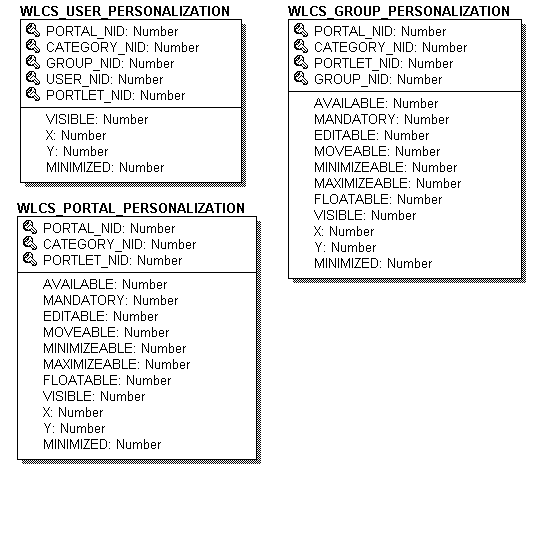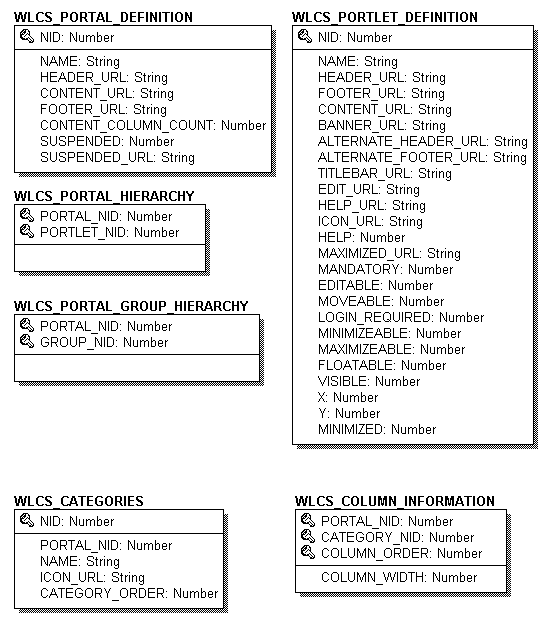


|

|
|
|
|
Portal Management Database Schema
This topic documents the database schema for the WebLogic Personalization Server Portal Management package. This topic includes the following sections:
The Entity-Relation Diagram
Figure 7-1 shows the logical Entity-Relation diagram for the WebLogic Commerce Server Portal and Portlet tables in the Commerce database. See the subsequent sections in this chapter for information about the data type syntax.
Figure 7-1 Entity-Relation Diagram for the Portal and Portlet Tables
Figure 7-2 lists the tables used for the example portal. Note: These tables are listed in the database schema chapter for the WebLogic Personalization Server. Figure 7-2 Tables Used for the Example Portal

List of Tables Comprising the Portal Management Package
Portal Management tables:
The WLCS_CATEGORIES Database Table
The WLCS_COLUMN_INFORMATION Database Table
The WLCS_PORTAL_DEFINITION Database Table
The WLCS_PORTLET_DEFINITION Database Table
The WLCS_PORTAL_HIERARCHY Database Table
The WLCS_PORTAL_GROUP_HIERARCHY Database Table
The WLCS_GROUP_PERSONALIZATION Database Table
The WLCS_PORTAL_PERSONALIZATION Database Table
The WLCS_USER_PERSONALIZATION Database Table
The Tables Used for the Sample Portal:
The WLCS_BOOKMARKS Database Table
The WLCS_CATEGORIES Database Table
The WLCS_COLUMN_INFORMATION Database Table
The WLCS_GROUP_PERSONALIZATION Database Table
The WLCS_IS_ALIVE Database Table
The WLCS_LDAP_CONFIG Database Table
The WLCS_SEQUENCER Database Table
The WLCS_UNIFIED_PROFILE_TYPE Database Table
The WLCS_USER_GROUP_CACHE Database Table
The WLCS_USER_PERSONALIZATION Database Table
The WLCS_UUP_EXAMPLE Database Table
The Portal Management Data Dictionary
In this section, the Portal and Portlet schema tables are arranged alphabetically as a data dictionary.
Note: Even though the following documentation references "foreign keys" to various tables, these constraints do not currently exist in this release of WebLogic Personalization Server. However, they will be (available in future releases) in place in future versions of WebLogic Personalization Server and we want you to be aware of these relationships now.
The WLCS_BOOKMARKS Database Table
Table 7-1 describes the WLCS_BOOKMARKS table. This table is used by the Example portal and is not used except for demonstration purposes. It contains information used in the Bookmark portlet.
The Primary Key is comprised of NAME and OWNER.
The WLCS_CATEGORIES Database Table
Table 7-2 describes the WLCS_CATEGORIES table. This table is used to store category information for the portal portion of the WebLogic Personalization Server application.
Note: The CATEGORY feature has not been implemented at this time and, therefore, this table is not being used/populated.
The Primary Key is NID.
The WLCS_COLUMN_INFORMATION Database Table
Table 7-3 describes the WLCS_COLUMN_INFORMATION table. This table is used to store column definition information for each portal and category.
The Primary Key is comprised of PORTAL_NID, CATEGORY_NID and COLUMN_ORDER.
The WLCS_IS_ALIVE Database Table
Table 7-4 describes the WLCS_IS_ALIVE table. This table is used by the JDBC connection pools to insure the connection to the database is still alive.
There is no Primary Key
The WLCS_LDAP_CONFIG Database Table
Table 7-5 describes the WLCS_LDAP_CONFIG table. This table holds configuration information for LDAP functionality within the User Management module.
There is no Primary Key.
|
Column Name |
Data Type |
Description and Recommendations |
|---|---|---|
|
LDAP_PROPERTY |
VARCHAR(100) |
The property name. |
|
LDAP_VALUE |
VARCHAR(254) |
The property value. |
The WLCS_PORTAL_DEFINITION Database Table
Table 7-6 describes the WLCS_PORTAL_DEFINITION table.
The Primary Key is NID.
The WLCS_PORTAL_GROUP_HIERARCHY Database Table
Table 7-7 describes the WLCS_PORTAL_GROUP_HIERARCHY table. This table maintains records showing which groups are associated with each portal.
The Primary Key is comprised of PORTAL_NID and GROUP_NID.
The WLCS_GROUP_PERSONALIZATION Database Table
Table 7-8 describes the WLCS_GROUP_PERSONALIZATION table. Portals can be associated to groups and this table helps establish those relationships and maintain specific information for the group.
The Primary Key is comprised of PORTAL_NID, CATEGORY_NID, PORTLET_NID and GROUP_NID.
The WLCS_PORTAL_HIERARCHY Database Table
Table 7-9 describes the WLCS_PORTAL_HIERARCHY table. This table contains records showing which portlets are associated with each portal.
The Primary Key is comprised of PORTAL_NID and PORTLET_NID.
The WLCS_PORTAL_PERSONALIZATION Database Table
Table 7-10 describes the WLCS_PORTAL_PERSONALIZATION table. This table maintains information pertinent to each personalized portal definition.
The Primary Key is comprised of PORTAL_NID, CATEGORY_NID and PORTLET_NID.
The WLCS_PORTLET_DEFINITION Database Table
Table 7-11 describes the WLCS_PORTLET_DEFINITION table. This table maintains information pertinent to each portlet definition.
The Primary Key is comprised of NID.
The WLCS_SEQUENCER Database Table
Table 7-12 describes the WLCS_SEQUENCER table. The WLCS_SEQUENCER table is used to maintain all of the sequence identifiers (for example, property_meta_data_id_sequence, and so on) used in the application.
There is no Primary Key.
The WLCS_TODO Database Table
Table 7-13 describes the WLCS_TODO table. This table is used by the Example portal and is not used except for demonstration purposes. It contains information used in the To Do portlet.
The Primary Key is ITEM and OWNER.
The WLCS_UIDS Database Table
Table 7-14 describes the WLCS_UIDS table. This table stores sequence information in a generic database independent format.
The Primary Key is SID.
The WLCS_UNIFIED_PROFILE_TYPE Database Table
Table 7-15 describes the WLCS_UNIFIED_PROFILE_TYPE table. This table allows registration of classes which extend the ProvidedUser class.
There is no Primary Key.
The WLCS_USER_GROUP_CACHE Database Table
Table 7-16 describes the WLCS_USER_GROUP_CACHE table. In the event of a deep group hierarchy, this table will flatten the group hierarchy and enables quick group membership searches.
Note: The startup process GroupCache is disabled by default. This table will only be used if enabled.
The Primary Key is comprised of both USER_NAME and GROUP_NAME.
The WLCS_USER_PERSONALIZATION Database Table
Table 7-17 describes the WLCS_USER_PERSONALIZATION table.This table contains personalized portal information for the user.
The Primary Key is comprised of PORTAL_NID, CATEGORY_NID, GROUP_NID, USER_NID and PORTLET_NID.
The WLCS_UUP_EXAMPLE Database Table
Table 7-18 describes the WLCS_UUP_EXAMPLE table. This is an example of how to use the Unified Profile Types.
There is no Primary Key.
The SQL Scripts Used to Create the Database
The database schemas for the WebLogic Personalization Server, WebLogic Commerce Server and BEA's Campaign Manager for WebLogic are all created by executing the create_all script for the target database environment.
Cloudscape
For Cloudscape, execute one of the following:
Oracle
For Oracle, from the command line, move to the following directory:
WL_COMMERCE_HOME/db/oracle/8.1.6
After logging into SQL*PLus, simply execute the create_all.sql script (e.g., @create_all).
Defined Constraints
There are no constraints associated with this part of the schema.

|

|

|
|
|
|
Copyright © 2001 BEA Systems, Inc. All rights reserved.
|